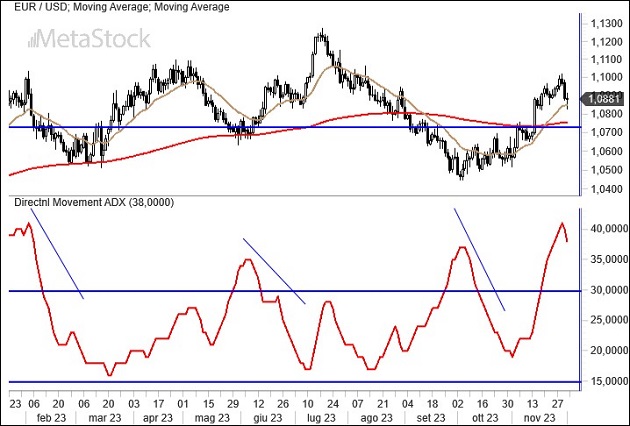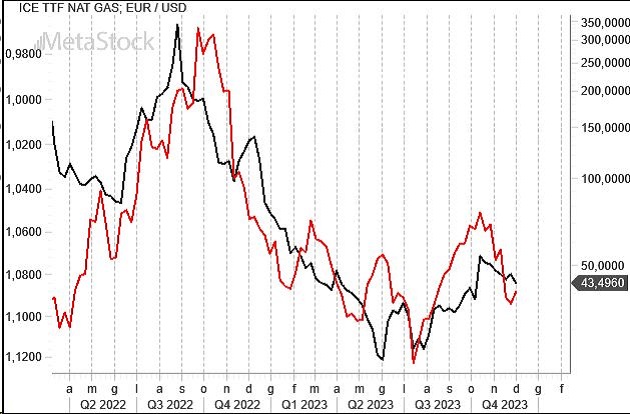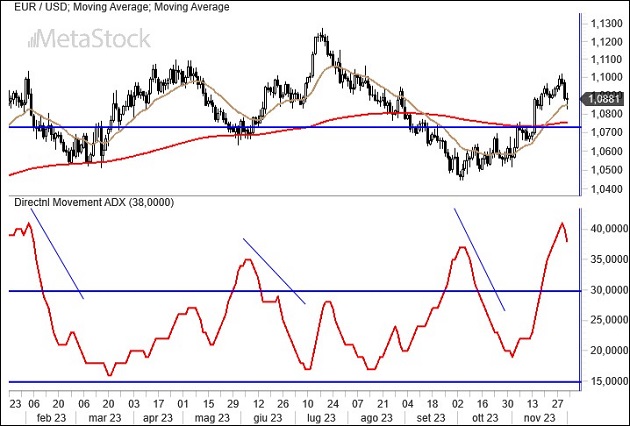- Markets on standby awaiting central bank decisions in December, a month traditionally unfavorable to the dollar. Meanwhile, the revised American GDP positively surprises, with Powell maintaining a neutral stance.
- Europe continues to improve in terms of inflation. November’s preliminary data show a decrease, but economic growth also slows, suggesting the ECB might be ready to cut interest rates in the first half of 2024.
- EurUsd remains close to key resistance levels, which, with seasonal factors in its favor, could soon be overcome.
EurUsd Trends: Central Bank Decisions and Market Speculation in Focus
The market is now focused on the meetings of central banks, the ECB and the FED. Paradoxically, both the euro and the dollar boast positive balances in the futures market among speculators. This implies that significant movements could concentrate on other currencies (Aud, Nzd, Jpy), exacerbated by excessive short positions by those speculating on dominant trends. Both the euro and the dollar currently have net long balances, meaning traders are not betting against the European single currency, which makes the idea of EurUsd significantly higher than current levels in 2024 less ambitious. We’ll revisit this topic shortly.
Even in a week with little macroeconomic data interest, we can’t overlook how the month of December represents a seasonally favorable point for EurUsd. The single currency has risen in 70% of the instances observed over the last 20 years against the US dollar. Statistically, there’s no better month for the euro, which has risen an average of 1.1% in 14 of the past two decades. The best return was in 2008 when the single currency managed to rise by over 10%. December indeed seems to hold the best cards for the euro, as we’ll soon see.
Following the revised upward US GDP for the third quarter (+5.2%), America is heading towards the mid-December FOMC with the belief that the FED will remain on standby on rates, waiting to see employment and inflation data. In the Eurozone, November’s inflation reading confirms the ongoing slowdown. The headline figure was expected at +2.7% year-on-year and the core at +3.9%, confirming a gradual approach to the 2% target. In Italy, inflation even fell below 1%. The first price cuts are priced in from April 2024 onwards.
Technical Analysis – EurUsd’s Seasonal Strength and Market Outlook
Always a key indicator for those trying to gauge the strength of a dominant trend, the ADX is only now beginning to show signs of uncertainty on EurUsd, but we still don’t see divergences, suggesting that the trend is gaining momentum from buyers eager to enter. Only in the presence of divergence between ADX and prices can we start to consider a potential EurUsd top, a pattern that is not yet visible on the horizon. However, short-term moving averages must support the rise.

We revisit a chart that compares EurUsd (on an inverted scale) with the price of European natural gas, now declining again following a surge in November. A mild winter in Europe and especially maximum strategic reserves have eased pressure on gas prices, allowing lower costs for consumer bills. But also a somewhat stronger euro. As seen from the weekly scale chart, the parallel between the two magnitudes is striking, at least since the onset of the war in Ukraine. And the recent fallback in gas is favoring the recovery of EurUsd.



Leave a Reply
You must be logged in to post a comment.